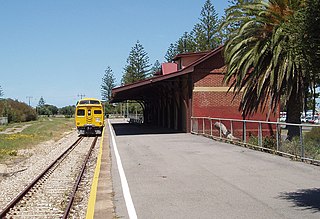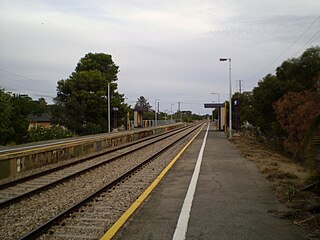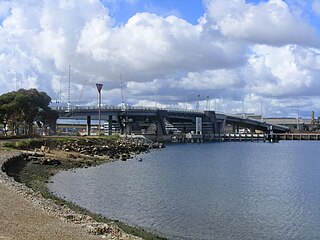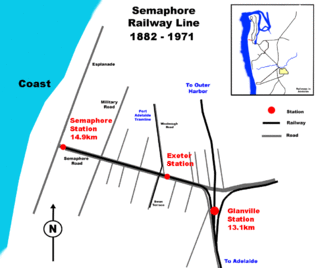
Adelaide railway station is the central terminus of the Adelaide Metro railway system. All lines approach the station from the west, and it is a terminal station with no through lines, with most of the traffic on the metropolitan network either departing or terminating here. It has nine below-ground platforms, all using broad gauge track. The station is located on the north side of North Terrace, west of Parliament House.

Port Adelaide railway station is a commuter railway station located on the Outer Harbor line. It serves the port-side region of Port Adelaide. It originally opened as Commercial Road, the current name of Port Adelaide was given in 1981. Situated in the north-western Adelaide suburb of Alberton, it is 11.7 kilometres from Adelaide station.

Woodville railway station is the junction station for the Grange, Outer Harbor and Port Dock lines with the lines diverging immediately north of the station. Situated in the western Adelaide suburb of Woodville, it is 7.5 kilometres from Adelaide station. It has auto pedestrian gates and lights. Platform 3 had a small kiosk, built around 2006, that sells refreshments and tickets, but has not been opened since 2009.

The Adelaide rail network is a metropolitan suburban rail system serving the city of Adelaide, South Australia, Australia. It consists of 89 railway stations across 7 lines, which served a patronage of 15.6 million people over the year 2018-19. Keolis Downer under contract from the Government of South Australia operates the Adelaide suburban rail system. The operations are set to be handed back to the hands of the public by January 2025.

Bowden railway station is located on the Adelaide suburban railway line leading to the Grange, Outer Harbor and Port Dock lines, commonly known as the Port line. Situated in the inner Adelaide suburb of Bowden, it is 2.5 kilometres from Adelaide station. Originally opened in 1856, it was extensively rebuilt as part of a flying junction in 2017 and reopened in 2018.

Alberton railway station is the junction station for the Outer Harbor and Port Dock lines. Situated in the north-western Adelaide suburb of Alberton, it is 10.2 kilometres from Adelaide station. The station is listed on the South Australian Heritage Register.

Ethelton station is located on the Outer Harbor line. Situated in the north-western Adelaide suburb of Ethelton, it is 13.1 kilometres from Adelaide station.

The Dry Creek–Port Adelaide railway line is an eight-kilometre east–west freight railway line running through Adelaide's north-western suburbs. The line is managed by the Australian Rail Track Corporation (ARTC) and is an important link between Port Adelaide, Pelican Point and the main interstate rail routes which link Adelaide with Melbourne, Perth, Darwin and Sydney. Prior to 1988, a limited local passenger service operated, stopping at five intermediate stations along the line. Since May 1988, the line has been freight-only.

The Outer Harbor line is a suburban commuter service in Adelaide, South Australia, that runs from Adelaide station through the north western suburbs to Port Adelaide and Outer Harbor.

The Grange line is a suburban branch line in Adelaide, South Australia. It is 13.0 kilometres long.

Outer Harbor railway station is the terminus station of the Outer Harbor line. Situated in the north-western Adelaide suburb of North Haven, it is 21.9 kilometres from Adelaide station.

Albert Park railway station is located on the Grange line. Situated in the western Adelaide suburb of Albert Park, it is 9.1 kilometres from Adelaide station.

Midlunga railway station is a railway station located on the Outer Harbor line, in Adelaide, Australia. Situated in the north-western Adelaide suburb of Osborne, South Australia, it is 18.8 kilometres (11.7 mi) from Adelaide station.

Peterhead railway station is located on the Outer Harbor line. Situated in the north-western Adelaide suburb of Peterhead, it is 14.6 kilometres from Adelaide station.

Glanville railway station is located on the Outer Harbor line. Situated in the north-western Adelaide suburb of Glanville, it is 13.8 kilometres from Adelaide station.

Birkenhead is a north-western suburb of Adelaide 14 km from the CBD, on the Lefevre Peninsula, in South Australia, and lies within the City of Port Adelaide Enfield. It is adjacent to Peterhead, Exeter and Glanville. It is bounded to the south by the Gawler Reach of the Port River, to the north by Hargrave Street and in the west and east by the Outer Harbor railway line and the Port River respectively.
Ethelton is a north-western suburb of Adelaide 13 km (8.1 mi) from the CBD, on the Lefevre Peninsula, in the state of South Australia, Australia. It is a residential suburb within the local government area of City of Port Adelaide Enfield, adjacent to the suburbs of Semaphore, Semaphore South, Glanville and New Port. It is bounded to the north by Hart Street, to the south by Bower Road and in the west by Swan Terrace and in the east by Causeway Road.

The National Railway Museum, Port Adelaide, South Australia is the largest under-cover railway museum in Australia. More than 100 major exhibits, mainly from the South Australian Railways (SAR) and Commonwealth Railways and their successor, Australian National, are displayed at its 3.5-hectare (8.6-acre) site. A large archival collection of photographs of those railways and records created by them is also managed by the museum. The museum operates with a large number of volunteers.

Semaphore railway line was a railway line in the Australian state of South Australia located in the north-west of Adelaide servicing the suburbs of Semaphore and Exeter. It had two stations: Semaphore and Exeter. The line opened in 1878 and closed in 1978.



















